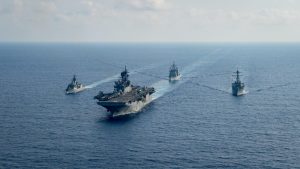Australia, a state party to the United Nations Convention on the Law of the Sea (UNCLOS), has long maintained that it was neutral with respect to maritime disputes in the South China Sea. Australia’s submission of a Note Verbale to the Commission on the Limits of the Continental Shelf (CLSC) on July 23 changed previous policy and came in the wake of a major change in U.S. policy made by Secretary of State Mike Pompeo 10 days earlier.
Australia jumped from its perch of neutrality to align itself with the United States in supporting UNCLOS and the 2016 Award by the Arbitral Tribunal that heard the case brought by the Philippines against China. However, Australia went further and was more precise in its rejection of the legal basis of China’s maritime claims in the South China Sea.
For example, Australia rejected China’s assertion that its sovereignty claims over the Paracel and Spratly islands were “widely recognized by the international community.” Australia took note of protests by Vietnam and the Philippines to document its case. This is the first time the Paracel Islands had been mentioned in a string of Notes Verbales submitted to the CLCS since December 2019.
It should be noted, however, that Australia remains neutral on various claims to sovereignty over the Paracel Islands.
Australia also expressed its “strong concern” over assertions by China that it had “continuously and effectively” exercised sovereignty over low tide elevations precisely because low tide elevations “do not form part of the land territory of a State.”
In line with the Award by the Arbitral Tribunal, Australia rejected China’s claims to “historic rights” and went further to reject claims to “maritime rights and interests” established by “historical practice.”
Australia’s Note Verbale commenced with a direct rejection of “any claims by China that are inconsistent with the 1982 United Nations Convention on the Law of the Sea (UNCLOS)” particularly with respect to drawing baselines, delimiting maritime zones, and classifying features. Specifically, Australia argued that China had “no legal basis… to draw straight baselines connecting the outermost points of maritime features or ‘island groups’ in the South China Sea” with specific reference to what China calls the “four sha” – the Pratas Islands, Macclesfield Bank, the Paracel Islands, and the Spratly Islands.
Further, following the United States, Australia also rejected any claims by China to “internal waters, territorial sea, exclusive economic zone and continental shelf based on such straight baselines.”
With respect to maritime zones, Australia rejected Chinese assertions to maritime zones generated by submerged features such as low tide elevations. Australia went further by specifically rejecting claims to maritime zones based on the artificial transformation of natural features. Australia declared it “does not accept that artificially transformed features can ever acquire the status of an island.”
Australia concluded its Note Verbale by calling on all claimants to clarify their maritime claims and resolve differences peacefully. Finally, Australia reserved the right to take up other aspects of claims made by China at a future time.
Shortly after Pompeo’s July 13 press statement, Prime Minister Scott Morrison stated, “We back that up [Australia’s support for freedom of navigation] with our own actions and our own initiatives and our own statements but we’ll say it the Australian way, we’ll say it the way it’s in our interests to make those statements and continue to adopt a very consistent position.” This was viewed by some observers as an attempt to differentiate Australia’s approach to China from that of the United States.
So what explains Australia’s change of declaratory policy? It is likely Australia quickly became aware that Pompeo’s press statement was the first salvo in an anti-China offensive by senior Trump administration officials (also including National Security Advisor Robert O’Brien, FBI Director Chris Wray, and Attorney General William Barr) that reached a crescendo on July 23 with a major speech by the secretary of state at the Nixon Library in California. Pompeo called on all free nations to summon the courage to rise as one against Chinese tyranny.
It should be noted that Pompeo acknowledged there would be differences among “free nations” in his July 23 speech. He said, “Not every free nation will approach China in the same way, nor should they. Every nation will have to come to its own understanding of how to protect its own economic prosperity, and how to protect its ideals from the tentacles of the Chinese Communist Party.”
Morrison was well aware that the annual Australia-United States ministerial consultations, or AUSMIN, were scheduled for July 28. These talks include the ministers of foreign affairs and defense on both sides. On the same day that Pompeo spoke, Australia discreetly aligned its position on the South China Sea with the United States by submitting a Note Verbale to the CLCS.
Australia’s Note Verbale must be placed in a broader context. On July 1, the Morrision Government released its 2020 Defense Strategic Update and 2020 Force Structure Plan. These documents, while not identifying China by name, expressed concern that “the rules-based global order is being undermined by disruptions from a widening range of sources.” In particular, Canberra warned that “The conduct of ‘grey-zone’ activities has also expanded in the Indo-Pacific. These activities involve military and non-military forms of assertiveness and coercion aimed at achieving strategic goals without provoking conflict,” with “militarization of the South China Sea” cited as the first example.
Morrison’s comments that Australia would take “our own actions and our own initiatives” were in fact a pledge that Australia would engage more with Southeast Asia and the South Pacific. Australia’s Foreign Minister Marise Payne and Defense Minister Linda Reynolds penned a joint article in The Australian newspaper on the eve of their departure to Washington for AUSMIN. They wrote that Australia looked “to widen and deepen our friendships across the Indo-Pacific” in tandem with “our alliance with the US.” Indonesia and Vietnam are widely tipped to be priority countries.
































